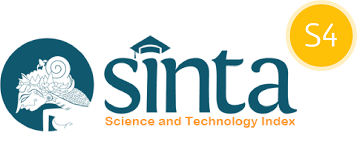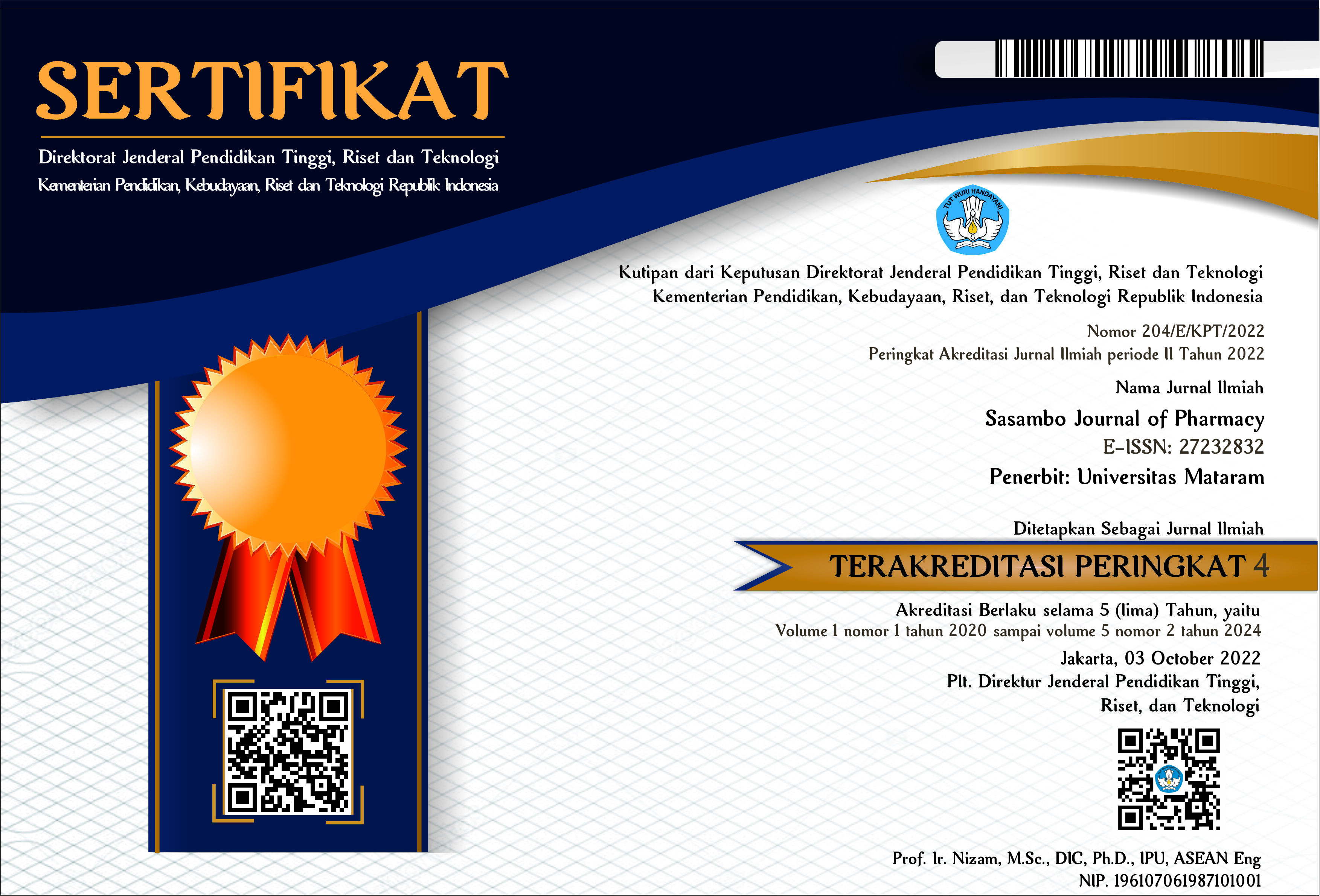Molecular docking study of natural compounds from red betel (Piper crocatum Ruiz & Pav) as inhibitor of secreted aspartic proteinase 5 (Sap 5) in Candida albicans
DOI:
10.29303/sjp.v3i2.145Downloads
Abstract
Candida albicans can cause adverse infections in humans. The targeting of Sap 5 is due to its virulence factor in C. albicans. The method used is molecular docking using YASARA structure and BIOVIA Discovery Studio. The purpose of this study was to investigate the molecular interaction between red betel and Sap 5 as a potential inhibitor of C. albicans in infecting humans. The results showed that CHEMBL216163 (9,644 kcal/mol) and MLS000557666 (9,525 kcal/mol) have Binding energy above Pepstatin (9,484 kcal/mol) and affect the active site of Sap 5 so that the two test ligands could be further analyzed.
Keywords:
Candida albicans, Sap 5, Molecular docking, YASARAReferences
Ali, N. S. M., Salleh, A. B., Leow, T. C., Rahman, R. N. Z. R. A., & Ali, M. S. M. (2020). The Influence of Calcium toward Order/Disorder Conformation of Repeat-in-Toxin (RTX) Structure of Family I.3 Lipase from Pseudomonas fluorescens AMS8. Toxins, 12(579), 1–14. https://doi.org/10.3390/toxins12090579
Aamir, M., Singh, V. K., Dubey, M. K., Meena, M., Kashyap, S. P., Katari, S. K., … Singh, S. (2018). In silico Prediction, Characterization, Molecular Docking, and Dynamic Studies on Fungal SDRs as Novel Targets for Searching Potential Fungicides Against Fusarium Wilt in Tomato. Frontiers in Pharmacology, 9(OCT), 1–28. https://doi.org/10.3389/fphar.2018.01038
Borelli, C., Ruge, E., Jung, H. L., Schaller, M., Vogelsang, A., Monod, M., … Maskos, K. (2008). X-ray structures of Sap1 and Sap5: Structural comparison of the secreted aspartic proteinases from Candida albicans. Proteins: Structure, Function and Genetics, 72(4), 1308–1319. https://doi.org/10.1002/prot.22021
Bilal, S., Hassan, M. M., ur Rehman, M. F., Nasir, M., Sami, A. J., & Hayat, A. (2021). An insect acetylcholinesterase biosensor utilizing WO3/g-C3N4 nanocomposite modified pencil graphite electrode for phosmet detection in stored grains. Food Chemistry, 346, 128894. https://doi.org/10.1016/j.foodchem.2020.12889
Cortes-Benitez, F., Roy, J., Perreault, M., Maltais, Rene., & Poirier, D. (2021). 16-Picolyl-androsterone derivative exhibits potent 17β-HSD3 inhibitory activity, improved metabolic stability and cytotoxic effect on various cancer cells: Synthesis, homolgy modeling and docking studies. Journal of Steroid Biochemistry and Molecular Biolody, 210, 105846. https://doi.org/10.1016/j.jsbmb.2021.105846
Cojocaru, C., & Clima, L. (2020). Polymer assisted ultrafiltration of AO7 anionic dye from aqueous solutions: Experimental design, multivariate optimizationm and molecular docking insight. Journal of Membrane Science, 604, 118054. https://doi.org/10.1016/j.memsci.2020.118054
Dhoke, G. V., Ensari, Y., Davari, M. D., Ruff, A. J., Schwaneberg, U., & Bocola, M. (2016). What’s My Substrate? Computational Function Assignment of Candida parapsilosis ADH5 by Genome Database Search, Virtual Screening, and QM/MM Calculations. Journal of Chemical Information and Modeling, 56(7), 1313–1323. https://doi.org/10.1021/acs.jcim.6b00076
Dhorajiwala, T. M., Halder, S. T., Samant, L. (2019). Comparative in silico molecular docking analysisof L-Threonine-3-Dehydrogenase, a protein target against african trypanosomiasis using selected phytochemicals. J App Biotechnol, 6(3), 101-108. doi:10.29252/JABR.06.03.04
de Freitas, R. F., & Schapira, M. (2017). A systematic analysis of atomic protein-ligand interactions in the PDB. Med. Chem. Commun., 8, 1970. doi: 10.1039/c7md00381a
Fatima, B., Zaelani, D., Safithri, M., & Andrianto, D. (2021). Molecular Docking of Red Betel (Piper crocatum Ruiz & Pav) Bioactive Compounds as HMG-CoA Reductase Inhibitor. Jurnal Kimia Sains dan Aplikasi Bioactive, 24(3), 101–107.
Feher, M., & Williams, C. I. (2009). Effect of input differences on the results of docking calculations. Journal of Chemical Information and Modeling, 49(7), 1704–1714. https://doi.org/10.1021/ci9000629
Forlemu, N., Watkins, P., & Sloop, J. (2017). Molecular Docking of Selective Binding Affinity of Sulfonamide Derivatives as Potential Antimalarial Agents Targeting the Glycolytic Enzymes: GAPDH, Aldolase and TPI. Open Journal of Biophysics, 07(01), 41–57. https://doi.org/10.4236/ojbiphy.2017.71004
Gholam, G. M. (2022a). Molecular docking of the bioactive compound Ocimum sanctum as an inhibitor of Sap 1 Candida albicans. Sasambo Journal of Pharmacy, 3(1), 18-24. https://doi.org/10.29303/sjp.v3i1.157
Gonzalez, T. L., Rae, J. M., Colacino, J. A., Richardson, R. J. (2019). Homology models of mouse and rat estrogen receptor- α ligand-binding domain created by in silico mutagenesis of a human template: Molecular docking with 17β-estradiol, diethylstilbestrol, and paraben analogs. Computational Toxicology, 10, 1-16. https://doi.org/10.1016/j.comtox.2018.11.003
Gholam, G. M., Firdausy, I. A., Artika, I. M., Abdillah, R. M., & Firmansyah, R. P. (2022). Molecular docking: Bioactive compounds of Mimosa pudica as an inhibitor of Candida albicans Sap 3. bioRxiv. https://doi.org/10.1101/2022.09.06.506736
Gholam, G. M. (2022b). Minyak Atsiri Kapulaga (Elettaria cardamomum) sebagai Inhibitor Sap 5 Candida albicans penyebab Kandidiasis Vulvovaginalis (KVV) secara In silico. [Skripsi, Institut Pertanian Bogor]. http://repository.ipb.ac.id/handle/123456789/112362
Krisnamurti, G. C., Bare, Y., Amin, M., & Primiani, C. N. (2021). Combination of Curcumin from Curcuma longa and Procyanidin from Tamarindus indica in Inhibiting Cyclooxygenases for Primary Dysmenorrhea Therapy: In silico study. Biointerface Research in Applied Chemistry, 11(1), 7460-7467. https://doi.org/10.33263/BRIAC111.74607467
Krieger, E., & Vriend, G. (2015). New Ways to Boost Molecular Dynamics Simulations. Journal of Computational Chemistry, 36, 996-1007. doi: 10.1002/jcc.23899
Lister, I. N. E., Ginting, C. N., Girsang, E., Nataya, E. D., Azizah, A. M., & Widowati, W. (2020). Hepatoprotective properties of red betel (Piper crocatum Ruiz and Pav) leaves extract towards H2O2-induced HepG2 cells via anti-inflammatory, antinecrotic, antioxidant potency. Saudi Pharmaceutical Journal, 28(10), 1182–1189. https://doi.org/10.1016/j.jsps.2020.08.007
Meenambiga, S. S., Venkataraghavan, R., & Abhishek Biswal, R. (2018). In silico analysis of plant phytochemicals against secreted aspartic proteinase enzyme of Candida albicans. Journal of Applied Pharmaceutical Science, 8(11), 140–150. https://doi.org/10.7324/JAPS.2018.81120
Masomian, M., Rahman, R., & Salleh, A. (2018). A Novel Method of Affinity Tag Cleavage in the Purification of a Recombinant Thermostable Lipase from Aneurinibacillus thermoaerophilus Strain HZ. Catalysts, 8(10), 479. https://doi.org/10.3390/catal8100479
Monod, M., Hube, B., Hess, D., & Sanglard, D. (1998). Differential regulation of SAP8 and SAP9, which encode two new members of the secreted aspartic proteinase family in Candida albicans. Microbiology, 144(10), 2731–2737. https://doi.org/10.1099/00221287-144-10-2731
Meyer, M., Wilson, P., & Schomburg, D. (1996). Hydrogen bonding and Molecular Surface Shape Complementarity as a Basis for Protein Docking. J. Mol. Biol., 264, 199-210.
National Library of Medicine. (n.d.). Pubchem Compound Search. National Center for Biotechnology Information. https://www.ncbi.nlm.nih.gov/pccompound/
Novoseletsky, V. N., Pyrkov, T. V., & Efremov, R. G. (2015). Analysis of hydrophobic interactions of antagonists with the beta2-adrenergic receptor. SAR and QSAR in Environmental Research, 21, 37-55. doi: 10.1080/10629360903560637
Patel, C. N., Goswami, D., Jaiswal, D. G., Parmar, R. M., Solanki, H. A., & Pandya, H. A. (2021). Pinpointing the potential hits for hindering interaction of SARS-CoV-2 S-protein with ACE2 form the pool of antiviral phytochemicals utilizing molecular docking and molecular dynamics (MD) simulations. Journal of Molecular Graphics and Modelling, 105, 107874. https://doi.org/10.1016/j.jmgm.2021.107874
Patel, C. N., Kumar, S. P., Pandya, H. A., & Rawal, R. M. (2020). identification of potential inhibitors of coronavirus hemagglutinin-esterase using molecular docking, molecular dynamics simulation and binding free energy calculation. Molecular Diversity, 25, 421-433. https://doi.org/10.1007/s11030-020-10135-w
Rentzsch, R., & Renard, B. Y. (2015). Docking small peptides remains a great challenge: An assessment using AutoDock Vina. Briefings in Bioinformatics, 16(6), 1045–1056. https://doi.org/10.1093/bib/bbv008
Srivastava, S., Shree, P., Pandey, H., & Tripathi, Y. B. (2018). Incretin hormones receptor signaling plays the key role in antidiabetic potential of PTY-2 against STZ-induced pancreatitis. Biomedicine & Pharmacotherapy, 97, 330-338. https://dx.doi.org/10.1016/j.biopha.2017.10.071
Uzzaman, M., Hasan, K. Md., Mahmud, S., Yousuf, A., Islam, S., Uddin, M. N., Barua, A. (2021). Physicochemical, spectral, molecular docking, and ADMET studies of Bisphenol analogues; A computational approach. Informatics in Medicine Unlocked, 25, 100706. https://doi.org/10.1016/j.imu.2021.100706
Venkatachalam, K. V., & Ettrich, R. H. (2021). Role of aspartic acid residues D87 and D89 in APS kinase domain of human 3′-phosphoadenosine 5′-phosphosulfate synthase 1 and 2b: A commonality with phosphatases/kinases. Biochemistry and Biophysics Reports, 28, 101155.https://doi.org/10.1016/j.bbrep.2021.101155
Westman, J., Plumb, J., Licht, A., Yang, M., Allert, S., Naglik, J. R., … Maxson, M. E. (2022). Calcium-dependent ESCRT recruitment and lysosome exocytosis maintain epithelial integrity during Candida albicans invasion. Cell Reports, 38(1), 110187. https://doi.org/10.1016/j.celrep.2021.110187
Wang, W., Gan, N., Sun, Q., Wu, D., Gan, R., Zhang, M., Tang, P., & Li, H. (2019). Study in the interaction of ertugliflozin with human serum albumin in vitro by multispectroscopic methods, molecular docking, and molecular dynamics simulation. Spectrochimica Acta Part A: Molecular and Biomolecular Spectroscopy, 219, 83-90. https://doi.org/10.1016/j.saa.2019.04.047
Yadav, S., Pandey, S. K., Singh, V. K., Goel, Y., Kumar, A., & Singh, S. M. (2017). Molecular docking studies of 3-bromopyruvate and its derivatives to metabolic regulatory enzymes: Implication in designing of novel anticancer therapeutic strategies. PLoS ONE, 12(5), 1–15. https://doi.org/10.1371/journal.pone.0176403
Zahra, H., Haridas, R. B., Gholam, G. M., Setiawan, A. G. (2022). Aktivitas antiulseratif berbagai tanaman herbal dan prospek masa depan sebagai tanaman budidaya. Jurnal Sains dan Kesehatan, 4(3), 343-353. https://doi.org/10.25026/jsk.v4i3.1046
License
Copyright (c) 2022 The Author(s)

This work is licensed under a Creative Commons Attribution 4.0 International License.
Authors who publish with Sasambo Journal of Pharmacy (SJP), agree to the following terms:
- Authors retain copyright and grant the journal right of first publication with the work simultaneously licensed under a Lisensi Creative Commons Atribusi 4.0 Internasional. This license allows authors to use all articles, data sets, graphics and appendices in data mining applications, search engines, web sites, blogs, and other platforms by providing an appropriate reference. The journal allows the author(s) to hold the copyright without restrictions and will retain publishing rights without restrictions.
- Authors are able to enter into separate, additional contractual arrangements for the non-exclusive distribution of the journal's published version of the work (e.g., post it to an institutional repository or publish it in a book), with an acknowledgment of its initial publication in Sasambo Journal of Pharmacy
- Authors are permitted and encouraged to post their work online (e.g., in institutional repositories or on their website) prior to and during the submission process, as it can lead to productive exchanges, as well as earlier and greater citation of published work (See The Effect of Open Access).







